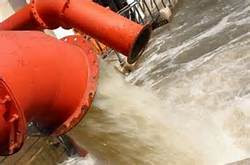
..................................................................................................................................................................
Worsening
Algal Blooms
What You Should Know
Alpine Technical Services (ATS)
Summer may be
winding down, but toxic algae is just heating up.
It feels like a
broken record with year-after-year of worsening algal blooms nationwide. It
begins when the temps heat up and releases toxic cyanobacteria,
(otherwise known as HABs) into the water.
These dangerous
toxins can impact aquatic, pet, and human health.
Just a few weeks
ago, a family dog from
Texas died from romping in a river filled with algal blooms.
The owner is now
warning other pet owners to be wary of toxic algae.
Read on to see why
there’s algal bloom outbreaks and what we can do to help.
Effects of Cyanobacteria on Health
An estimated 150
genera of cyanobacteria contain around 2000 species – 46 of these cyanotoxins
are considered toxic and produced by cyanobacteria, which causes health issues.
That may seem like
a small percentage, but it only takes one to infiltrate a public lake. When the
bacteria increase, the toxic effect grows worse.
Once the bacteria
are ingested, even if it’s a small amount you accidently swallow or eat from
contaminated shellfish can wreak havoc on your system.
It can have a mild
effect or a severe one, depending on the state of your health.
For pets, children,
and the elderly, the toxin can be severe enough to cause:
·
Neurotoxicity
·
Nervous system effects
·
Respiratory illness
·
Severe skin disease
·
Coma
·
Death
Why Toxic Algae Kills
It’s sad to hear a
beloved pet died from just swimming in a river for a short period of time.
We see it all the
time and it makes us cringe and want to shout it out to take algal blooms
seriously.
One day it could be
a family pet, the next day, an immune system-challenged beloved family member
or friend.
That green-blue
algae are not innocent – they can kill. Here’s why.
When an algal bloom
breaks out in public waterways, in some instances, it can be severe enough to
release high amounts of cyanobacteria into the water, thus producing
cyanotoxins – mainly neurotoxins, hepatoxins, or dermatoxins.
During daytime,
blooming cyanobacteria saturate the water with oxygen. However, at night,
respiring aquatic organisms can deplete the oxygen, so sensitive species of
fish die.
Cycling water
acidity during a bloom can also increase the pH to 9 or more during the day,
while dropping to low at night – this further stress the ecosystem.
And for the first
time ever in 2010, marine animals died from
ingesting cyanotoxins.
ATS Innova™ Can Reduce Worsening Algal Blooms
If you’re dealing
with algal blooms affecting the waterways in your community, please contact ATS
Innova at 855.215.4600. Our signature product, EarthTec®, has a proven performance
record. When you call us, you’ll get a water expert who offers a free
consultation and help to steer you to the right solution. We hope to hear from
you soon.
Alpine
Technical Services
(ATS) uses innovative methods and revolutionary products to solve issues with
waterways and water treatment. We partner with our customers and provide
the expertise, experience, technology and program management capabilities for
large-scale clean drinking water and wastewater projects.
Founded
in 1979, ATS excels in employing industry-best practices and protocols for
treating ultrapure water systems, industrial water, wastewater and municipal
drinking water, using water optimization and recovery systems along with
innovative chemistry and equipment. And we have the expertise to support
all our clients.
Visit: ATSInnova.com
https://atsinnovawatertreatment.com/blog/worsening-algal-blooms-what-you-should-know/

You might also like:
CLICK HERE . . . to view . . .
...............................................................................................................
CLICK HERE . . . to view . . .
...............................................................................................................
CLICK HERE . . . to view . . .
...............................................................................................................
CLICK HERE . . . to view . . .
...............................................................................................................
CLICK HERE . . . to view . . .



:max_bytes(150000):strip_icc():format(webp)/algae-in-lake-566af7b65f9b583dc32d2bb1.jpg)



No comments:
Post a Comment